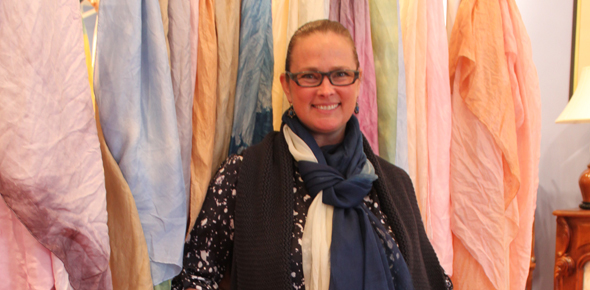
Nancy DeWeir Geaney huddles over a small cauldron of saffron-yellow liquid, with scraps of fabric, elastic and who knows what else bubbling into view.
What emerges is an objet d”™art that would catch the eye of the former supermodel”™s seafaring father ”“ a silk scarf that before long will find its way into a Wilton shop that is becoming a port of call of sorts for a small flotilla of artisans.
Une Minette proprietor Lauren Robak had invited Geaney to host a series of live demonstrations showing customers the ancient Japanese technique of shibori dyeing, which she uses to create scarves with intricate and unique patterns.
Five years after Robak launched Une Minette after her studies at New York City”™s Fashion Institute of Technology, she is expanding its business platform with the creation of its “Love Your Local Artist” trunk show series.
While the local shopping movement has received much press over the past few years, Robak saw a need to expand this trend to better help designers and artists.
“I wanted to have an event where we could work with a local artist and support the local stores at the same time,” Robak said.
“I didn”™t want to do just jewelry,” she was quick to add, since she finds that so many featured artists are jewelers.
Under her Vagabond”™s Daughter business, Geaney handcrafts hand-dyed silk scarves and other home goods, fashioned in her backyard using all-natural, plant-based dyes. It is not Geaney”™s first retail venture ”“ she also runs Dark Horse, which sells hand-stitched quilts.
Geaney says she derived the name of Vagabond”™s Daughter from a poem beloved by her father, who would bring Chinese silk home from his voyages that Geaney as a girl stitched into scarves.
Shibori came to her via a more familiar channel for many.
“I learned shibori, believe it or not, through tutorials on the Internet,” Geaney said, pointing at patterns on an Italian organza silk scarf. “These are golf balls that have been wrapped with rubber bands. Shibori is a way to create a graphic pattern through resist.”
Geaney enjoys the thrill “when something happens during the dyeing process that is maybe not planned ”“ it just happens but it doesn”™t bother me because it just makes each piece more individual.”
Rather than using food dyes like beets, which can fade red to pink over the years, Geaney uses long-lasting natural resources like lac, logwood, turmeric, chestnut and black walnut.
“Then you can use different things like iron to create splotchy effects, cream of tartar and alum to make the colors shift or be brighter,” she explained to a crowd of onlookers at one of her demonstrations.
“The dip-dyeing just takes a second,” she said. “It”™s all of the steps in between ”“ prepping the silk, dying, letting it dry, rinsing it and washing it again and then steam-stetting it to keep it from washing out ”“ that are so time-consuming.”
Not that a labor of love is any deterrent to an expansion of her business, if in a fashion industry that remains daunting.
“What I want to do is more higher-end pieces and more intricate techniques and stitching so that each piece is really like an art piece, (but) the thought of doing more than this is scary because I know the fashion world is really tough,” she said.



















